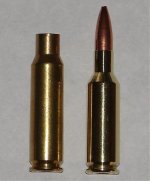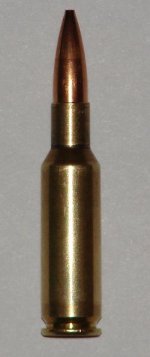30-30 Answers
A lot of people wonder why I shoot a 30-30. I have a lot of good reasons. The 30-30 was the first smokeless powder sporting cartridge, and while it has the lion's share of popularity in the deer hunting world, it was never considered a very accurate cartridge. I have shown in competition that it is more than capable of winning matches. I can honestly say that my 30-30's are the most winning bench guns I have ever competed with, and I have played with many including the PPC. The 30-30 is 118 years old. I won my first championship with it back in 1995. I called Winchester to see if they wanted to use my benchgun in a 100th year aniversary advertisement showing how accurate the cartridge really was. The answer was "why"? I said "to give it a boost in sales". He laughed at me and told me that they sell more 30-30 ammunition than any other cartridge.
I shoot groups and score. The 30-30 has proven just as good to me as any PPC could for group. It has trounced the PPC consistantly in the score matches. I shot in New Braunfalls for 3 years and I was competing against myself for score by setting new range records all three years. I had more confidence in that gun than I have ever had in any. Arnold Jewel and I used to shoot for quarters at 200 yards. The most X's was the game. Three X's was the norm for the 30-30, and four was even better. I always took Arnold's quarters, but one day when the gun just seemed to be shooting exceptional, I told Arnold that I was going to take his next quarter with 5 X's. He said that it never happens at 200 yards. The next target I fired scored 5 X's. The five shots would have been a mid .1" group at 200. All of you know that I'm no Tony Boyer. Saying that I have demonstrated the 30-30 to it fullest capability at winning matches would be as ignorant as saying that if I shot a 6PPC, I would become the top BR shooter. The fact is, I'm just not very good at all when it comes to match conditions. I used to be many times better than I am now, but that was before taking an 8 year break from benchrest. I hope it doesn't take years to get back waht I had at New Braunfalls.
Now some of you might want to know how the 30-30 idea came about in the first place. Back in the mid 90's, I was shooting club matches in Burnet, TX. I built my first BR action because I was a poor boy. I had a 6mm 14" twist Douglas stainless blank. I couldn't afford a reamer, so I ground a 6BR tight neck reamer, chambered it up, and just cleaned the barrel up leaving the gun around 17 pounds. The game was 200 yard unlimited bag gun. I chose the BR over the PPC because I would be shooting 70gr Sierra Matchkings to save money. Another reason was because we shot without flags, they were legal to use, but because we shot about seven different types of matches, nobody wanted to deal with them. As it turned out, my BR did well against the PPC and custom bullets. After winning the championship with the BR, a guy named Andy Lyda from Bertram asked me why I wasn't shooting a PPC. I told him that without flags, I felt the BR might have a small advantage at 200 yards. He continued to tease me about it until I decided to turn it around on him. I said "Andy, I could out shoot your PPC with any caliber". He said "what do you mean by any caliber". I said "a 30-06, a 308, even with a 30-30". Andy told me to put my money where my mouth is, show up with a 30-30 next year and I'd get laughed off the range.
On the drive home I just couldn't get it out of my mind. I knew we were both just joking around, but it seemed like to much of a challenge with his ending statement. I thought to myself, am I really stupid enough to show up with a 30-30? Then I thought "why not, it's all about having fun".
TJ Jackson had just passed away, and my father and I drove to Austin to buy some BR stuff from the estate. He had a used Shilen polygon rifled barrel that was still 28" in length. I ground another tight neck reamer, and chambered it up. Because it was a 14" twist I decided to try 150gr Matchkings and 38gr of IMR 4320. The gun shot increadibly well, and pushed the 150 a tad over 2800 fps.
Next BR season came around. After the first match and another win, nobody laughed me off the range. After the season was over, I had beat Andy 8 out of 8 matches for another easy championship. After my experiance with the 30-30, I knew it was the beginning of a lifetime love affair. Before the 30BR, I had already started shooting barrels in the 18" twist range with 110gr - 125gr bullets, and the first matches I won in New Braunfalls were shot with the 125 TNT Speer bullet.
Why the 22BRT? Back before I quit shooting 8 years ago. I took a 30-30 case and shortened it to PPC length. The capacity was perfect "Waldog" capacity. I called it the 22 Hummer because it would push a 52gr over 3600 fps. The case still had the large primer, so even though it seemed like it might have match winning potential, it was not easy to shoot an agg. smaller than a low .2" range. Now I know that size agg. has won plenty of matches, but I'm not talking about match conditions, I'm talking about dead calm, sun setting evening conditions. When the 6.8 SPC came out, I had a rimless case based on the 30-30 that was 222 length, had a small primer, and was way easier to form a short 22 from. My first testing was easy since I already had a barrel chambered up. The new cartridge proved to be "Waldog accurate", and is truley a 30-30 based American cartridge.
To sum it up, I have a ton of fun doing things my way.
Michael




